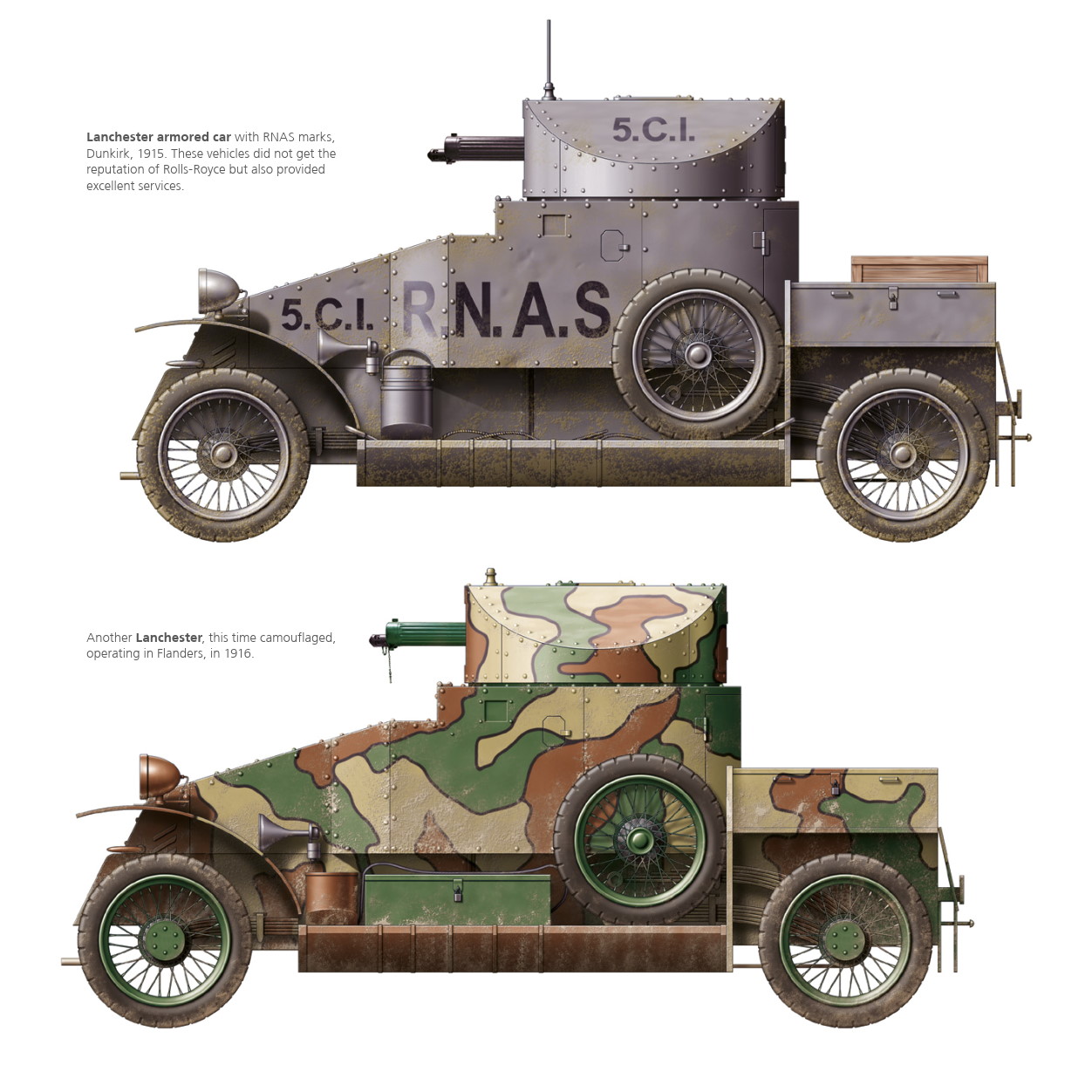
BRITISH WHEELED ARMORED VEHICLES
The first British armored vehicles were not used by the
Army, but rather the Royal Navy. In 1914 the Royal Naval Air Service had
already sent a mixed squadron of aircraft and land vehicles to France and
Belgium. Once there, some of the naval officers observed the use of the Belgian
Minerva armored cars and decided to imitate them.
Within days, some of the passenger cars like the Rolls Royce
Silver Ghost used by the RNAS, were armored in Dunkerque with plates on their
sides and out-fitted with a machine gun behind the driver. The Admiralty,
knowing the success of this conversion, endorsed the development of an armored
car based on the Silver Ghost. By the end of 1914 there were already the first
examples of armored vehicles in France which were armed with an Admiralty Model
1914 tower and up-armored with added plates with a maximum thickness of 9 mm
becoming an improved version of the Silver Ghost. Crossbows were also
strengthened so that they could support the extra weight added by the tower and
shield. The shield was spread throughout the chassis and the tower which had a
Vickers 7.7 mm machine gun. The radiator had a blast door and the roof of the
tower could be removed at will.
In March 1915, the first squadrons with armored vehicles,
mostly Rolls-Royce’s, had already been organized in France. These vehicles made
recon- naissance patrols in the French and Belgian coastal areas until the
advance to the sea of the German Army’s arrival at the Channel. Trench warfare
was impossible with these vehicles. After the activity in the front was
paralyzed, there was little need for the Rolls-Royce, which were used to make
anti-invasion patrols in the east coast of Britain.
Shortly after, the RNAS squadrons were disbanded and transferred
to the Army, which did not seem interested in them. However, Rolls-Royce
armored cars were used on other fronts like the northwest frontier of India in
the Gallipoli campaign, in German South West Africa, and in Uganda. However, in
the desert of the Arabian Peninsula, the Rolls-Royce performed great deeds.
There they proved to be safe, effective, and fast vehicles with a re- markable
ability in difficult terrain.
LANCHESTER ARMORED VEHICLES
After Rolls Royce, the Lanchester was the largest of such
vehicles in the RNAS squadrons. Three squadrons of twelve units were organized
and sent to France. Initially these vehicles were intended for the protection
of air bases and the recovery of downed pilots but gradually they began to be
used in offensive missions.
In appearance, the Lanchester was very similar to Rolls
Royce, especially for carrying a similar tower on its sides. When the RNAS
vehicles were assigned to the Army in August 1915, it was found that the
variety was too much to maintain certain operational effectiveness and an
overall lack of spare parts. Ultimately it was decided to standardize the
Rolls-Royce and the Lanchester was dropped. One of these squadrons was
delivered to the Belgian Army and the rest returned to Britain.
In October 1915, the first squadron of the Armored Car
Division of the Royal Navy was organized with these vehicles and sent to
Russia. Once there, it had 22 vehicles in service and they took part in
countless battles in Caucasus, Romania and Galitzia all in support of the
Russian forces. Some units replaced the 7.7 mm Vickers machine gun for 37 mm
Hotchkiss cannon. The Lanchester remained in service with the Russian units up
to the ultimate failure of the Brusilov offensive. The Russian Empire was
embroiled in civil strife culminating in the triumph of the revolution. The
Lanchester no longer had any objectives to fulfill and they were shipped to
Britain.
AUSTIN ARMORED CAR MODEL 1918
Since the beginning of the hostilities in 1914, the Russian
Army had been using the British armored cars Austin and Austin-Putilov which
were built under license.
Some 1918 model Austin armored vehicles were used by the
British Tank Corps. Sixteen of them were sent to France by May 1918 and
assigned to the 17th (Armoured Car) Battalion of the Tank Corps. They were
armed with 8mm Hotchkiss Mle 14 machine guns. Their first introduction into
combat was on June 11, 1918 where they were in support of the French troops.
One of the most important battles in which they participated was the Battle of
Amiens on August 8th. The vehicles were used to tow over the trenches which
allowed them to operate behind German lines. They attacked the village of
Farmerville which was occupied by the Germans. At least three Austin’s were
lost in the campaign. In 1919, the Austin’s were used by the British in the
civil war in Ireland up until 1921.
At least twenty others were sent to the Caspian Sea in
February 1918, within a British unit known as the Dunsterforce, whose job was
to protect Baku oil tanks from the Turks. They were operating there until
November 1918 in cooperation with the White Russians. Finally, only eight remained
in service while most of them were retired due to mechanical problems.
In 1919, at least 16 other vehicles were sent to India. In
1921, they were drawn into the 8th Armored Car Company of the Tank Corps. They
remained there until at least 1923.
Some were used in Iraq and some of them were converted to
rail vehicles after changing out their wheels. In this role they often served
in pairs joined together in the rear. One of the vehicles was used to guide the
entire set in one direction while the other was used to direct the vehicles the
other way so as to avoid slow reverse circulation.